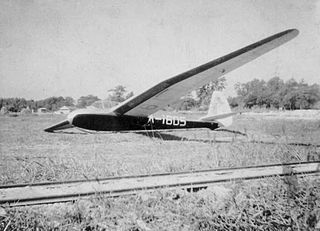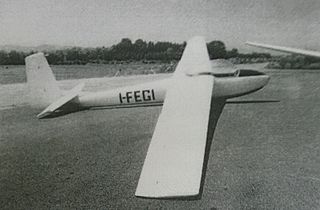Related Research Articles

The Antonov A-9 was a single-seat sailplane designed and built in the USSR in the 1940s, a development of the record setting Red Front 7.
The Kirigamine Mita is a training glider, seating two in tandem, designed in Japan in the early 1960s. A modified version, first flown in 1966, was produced in modest numbers.

The Maeda 703 was one of the first indigenous Japanese gliders, a high performance single seat aircraft which first flew in 1940. Three were built, two with gull wing wings; one of these set a national endurance record in 1941.
The CVV1 Pinguino was a single seat, high performance glider designed and built in Italy in the mid-1930s, the first of a series of gliders from the Milan Polytechnic. It did not go into production.
The CVV 2 Asiago is a simple, single seat glider designed and built in Italy in the mid-1930s, the second of a series of gliders from the Milan Polytechnic and the first go into production.
The Bonomi BS.4 Basettino was a primary glider designed and built in Italy in the 1930s.
The Bonomi BS.18 Airone was a single seat training glider, designed in Italy in 1936. Only one was built.
The Bonomi BS.28 Alcione, sometimes known as the Lombarda BS.28 Alcione, was a single seat competition sailplane designed and built in Italy in 1937-8. About four were completed, with two more or less refined fuselages.

The Aviamilano A2 or A2 Standard is an Italian high performance Standard Class sailplane first flown in 1964 and returned to production in 1966.

The Rotondi R.2 Tobia was built as a student group project in an Italian technical institute, begun in 1958. The sole example of this single seat, wooden glider first flew in 1962.
The Tedeschi E.T.186 was a simple, single seat training glider built in Italy and first flown in 1947. Only one was constructed.
The Romeo Ro.35, a.k.a.IMAM Ro.35 was a single-seat glider built in Italy in 1933.
The CVT1 Zigilo was a single-seat, 12-metre-span (39 ft) Italian training glider designed and built in Italy in the 1950s. Only one was completed.
The Teichfuss Gabbiano was an Italian, one-off, single seat, high performance glider, designed by Luigi Teichfuss and flown in 1928.
The Teichfuss Grifo was an Italian training glider designed by Luigi Teichfuss and flown in 1934. It was built in small numbers.
The Teichfuss Astore was an Italian Intermediate single-seat trainer glider designed by Luigi Teichfuss and flown in 1936. Two were built.
The IIL IS-4 was a single seat, high performance sailplane designed by Iosif Șilimon and built in Romania in the late 1950s.
The IIL IS-11 was an aerobatic, single seat glider, designed and built in Romania in 1959. It was built in small numbers.

The IFIL-Reghin RG-5 Pescăruș or CIL Reghin RG-5 Pescăruș was a Romanian single seat sailplane built in the 1950s. Twenty six were constructed for gliding clubs.
The DFS Sperber Junior was a competition sailplane designed for Hanna Reitsch and built in Germany in 1936.
References
- 1 2 3 4 5 6 Pedrielli, Vincenzo; Camastra, Francesco (2011). Italian Vintage Sailplanes. Königswinter: EQIP Werbung & Verlag GmbH. pp. 226–7. ISBN 9783980883894.
- 1 2 "CVP1 Arlecchino" . Retrieved 26 October 2013.
- 1 2 Taylor, John W R (1966). Jane's All the World's Aircraft 1966-67. London: Sampson Low, Marston & Co. Ltd. p. 395.